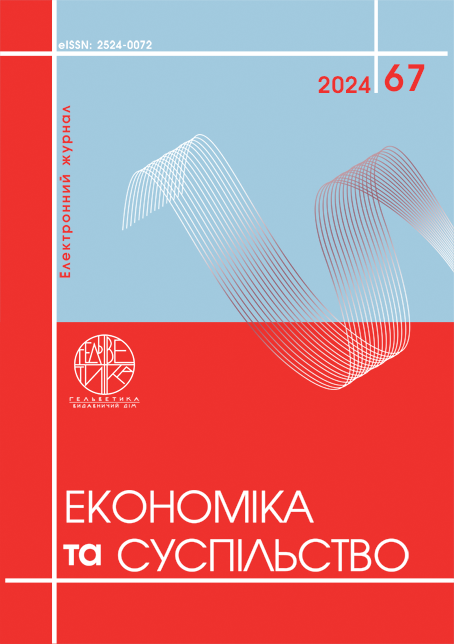PROFESSIONAL DEVELOPMENT PLANNING SPECIFICS OF THE ORGANIZATION'S STAFF
Abstract
The article is devoted to the problems of professional development planning and their features. The concept of professional development planning is considered in the context of rapidly changing technological and labor market landscapes. It aims to highlight the importance of continuous skill enhancement, knowledge acquisition, and competency development for professionals to remain competitive and effective in their fields. The process of assessing current skills and determining career goals is considered in detail, with a focus on self-assessment as a valuable tool for identifying areas for improvement and setting goals based on self-reflection. This involves determining strengths and development needs through feedback from colleagues and self-analysis. The article proposes establishing clear and achievable goals using the SMART (Specific, Measurable, Achievable, Relevant, Time-bound) criteria to guide efforts in specific areas and achieve measurable results. Processes for identifying resources and choosing tools for professional development are proposed, emphasizing their importance. The article offers such resources as: performance review, professional development plan (PDP), and mentorship. The following tools are also offered: a learning platform, tuition compensation, technical meetings, English language training, professional certifications, and participation in the professional community. The article also emphasizes the importance of discussing the development plan with management, ensuring alignment with organizational goals and obtaining necessary support. This includes setting SMART goals and obtaining feedback from leadership to refine the development plan and ensure it aligns with company objectives. Continuous development of professional skills is highlighted as a key to long-term success, involving adherence to the plan, ongoing education, regular feedback from supervisors, flexibility in career planning, and maintaining motivation. Professional development planning not only fosters personal success but also enhances organizational productivity and competitiveness.
References
Бабʼяк Г., Сич Т. Планування ділової карʼєри і професійного навчання персоналу на підприємстві. Регіональні аспекти розвитку продуктивних сил України. 2018. № 23. С. 95–98. URL: http://dspace.wunu.edu.ua/handle/316497/33754
Станьковська І.М., Михайлов Т.О. Планування професійного зростання в умовах сталого розвитку. Сталий розвиток складних соціально-економічних систем в умовах сучасних змін та викликів: матеріали I Міжнародної науково-практичної конференції (м. Івано-Франківськ, 16-17 травня 2024 р.). Івано-Франківськ: ІФНТУНГ, 2024. С. 295–297.
Parsons L. Why is Professional Development Important? Professional & Executive Development, Harvard division of Continuing Education. 2022. URL: https://professional.dce.harvard.edu/blog/why-is-professional-development-important/
Griffith N., Cline A. 79 Employee Training & Development Statistics. Supplygem. 2024. URL: https://supplygem.com/publications/employee-training-development-statistics/
World employment and social outlook: Trends 2023. International Labour Organization. 2023. DOI: https://doi.org/10.54394/SNCP1637
Zepeda S. Professional Development: What Works. Routledge. 2019.
Bolton G., Delderfield R. Reflective Practice : Writing and Professional Development. Sage Publications. 2018.
What Is Professional Development and What Are the Benefits? Coursera. 2024. URL: https://www.coursera.org/enterprise/articles/what-is-professional-development
Гріщенко І.В. Формування самооцінки як необхідної умови досягнення професійної компетентності. Матеріали Міжнародної науково-практичної інтернет-конференції “Інноваційні технології в процесі підготовки фахівців”. 2016. С. 53–55. URL: http://ir.lib.vntu.edu.ua//handle/123456789/28197
Ross J. The Reliability, Validity, and Utility of Self-Assessment. Practical Assessment, Research, and Evaluation. 2019. Vol. 11(10). DOI: https://doi.org/10.7275/9wph-vv65
Heathfield S. Steps to Create a Career Development Plan. The Balance. 2022. URL: https://www.thebalancemoney.com/steps-to-create-a-career-development-plan-1917798
Conzemius A., O'Neill J. The Power of SMART Goals. Solution Tree. 2005.
Triansyah F., Hejin W., Stefania S. Factors Affecting Employee Performance: A Systematic Review. Journal Markcount Finance. 2023. Vol. 3(1). Pp. 150–159. DOI: https://doi.org/10.55849/jmf.v1i2.102
Aguinis H., Kraiger K. Benefits of training and development for individuals and teams, organizations, and society. Annual Review of Psychology. 2009. Vol. 60(1). Pp. 451–474. DOI: https://doi.org/10.1146/annurev.psych.60.110707.163505
Afandi A. MENTORING PROGRAM: Empowerment and Human Resources Development. AKADEMIK: Jurnal Mahasiswa Humanis. 2021. Vol. 3(1). Pp. 87–94. DOI: https://doi.org/10.37481/jmh.v1i3.458
Babʼjak Gh., Sych T. (2018). Planuvannja dilovoji karʼjery i profesijnogho navchannja personalu na pidpryjemstvi [Planning of business career and professional training of personnel at the enterprise]. Reghionaljni aspekty rozvytku produktyvnykh syl Ukrajiny, 23, 95–98. Available at: http://dspace.wunu.edu.ua/handle/316497/33754
Stankovsjka I.M., Mykhailov T.O. (2024). Planuvannja profesijnogho zrostannja v umovakh stalogho rozvytku [Professional growth planning in conditions of sustainable development]. Stalyj rozvytok skladnykh socialjno-ekonomichnykh system v umovakh suchasnykh zmin ta vyklykiv: Zbirnyk tez dopovidej I Mizhnarodnoji naukovo-praktychnoji konferenciji (Ivano-Frankivsk, 16-17 travnja 2024 roku), Ivano-Frankivsk: IFNTUNG. P. 295–297.
Parsons L. (2022). Why is Professional Development Important? Professional & Executive Development, Harvard division of Continuing Education. Available at: https://professional.dce.harvard.edu/blog/why-is-professional-development-important/
Griffith N., Cline A. (2024). 79 Employee Training & Development Statistics. Supplygem. Available at: https://supplygem.com/publications/employee-training-development-statistics/
World employment and social outlook: Trends 2023. International Labour Organization. DOI: https://doi.org/10.54394/SNCP1637
Zepeda S. (2019). Professional Development: What Works. Routledge.
Bolton G., Delderfield R. (2018). Reflective Practice : Writing and Professional Development. Sage Publications.
Coursera. (2024). What Is Professional Development and What Are the Benefits? Available at: https://www.coursera.org/enterprise/articles/what-is-professional-development
Ghrishhenko I.V. (2016). Formuvannja samoocinky jak neobkhidnoji umovy dosjaghnennja profesijnoji kompetentnosti [Formation of self-esteem as a necessary condition for achieving professional competence]. Materialy Mizhnarodnoji naukovo-praktychnoji internet-konferenciji “Innovacijni tekhnologhiji v procesi pidghotovky fakhivciv”. P. 53–55. Available at: http://ir.lib.vntu.edu.ua//handle/123456789/28197
Ross J. (2019). The Reliability, Validity, and Utility of Self-Assessment. Practical Assessment, Research, and Evaluation, 11(10). DOI: https://doi.org/10.7275/9wph-vv65
Heathfield S. (2022). Steps to Create a Career Development Plan. Available at: https://www.thebalancemoney.com/steps-to-create-a-career-development-plan-1917798
Conzemius A., O'Neill J. (2005). The Power of SMART Goals. Solution Tree.
Triansyah F., Hejin W., Stefania S. (2023). Factors Affecting Employee Performance: A Systematic Review. Journal Markcount Finance, 3(1), 150–159. DOI: https://doi.org/10.55849/jmf.v1i2.102
Aguinis H., Kraiger K. (2009). Benefits of training and development for individuals and teams, organizations, and society. Annual Review of Psychology, 60(1), 451–474. DOI: https://doi.org/10.1146/annurev.psych.60.110707.163505
Afandi A. (2021). MENTORING PROGRAM: Empowerment and Human Resources Development. AKADEMIK: Jurnal Mahasiswa Humanis, 3(1), 87–94. DOI: https://doi.org/10.37481/jmh.v1i3.458

This work is licensed under a Creative Commons Attribution 4.0 International License.


